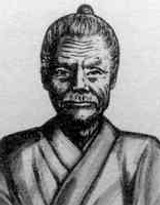“A Student of The Birdman Of Okinawa” Please Sharewith a friend or two.

Matsumora Kosaku 1829 – 1898
“A Student of The Birdman Of Okinawa”

Kosaku was an Okinawankarate master, a prominent bushi from the west side of Tomari village, Okinawa, where his family were indirect descendants of the first Sho king.
He studied Tomari-te under Karyu Uku (aka Giko Uku), and Kishin Teruya. He was also taught by “The Birdman” Makabe Chokun who was a student of Karate Sakugawa. Kosaku trained as well in a rare style of karate known as Jigen-ryu.
He studied with Karyu Uku for three years with emphasis on developing a strong foundation while learning to use his legs for mobility and hips to generate power. Master Uku taught three katas known in Tomari as Naihanchi. Matsumora next studied with with Teruya Kishin. He studied Jigen-ryu and learned the katas Bassai and Wanshu from the great master. Master Teruya was impressed and invited Matsumora to continue training at the family tomb. This was a great honour, because at this time the study of karate was practiced in secrecy, and very late at night. Being caught at practice meant certain death. At the family tomb Teruya taught Matsumora bunkai application training, so that he could understand the deeper movement of the kata and practice applications.
Among Matsumara’s students who were to influence new generations through study at this time were Choki Motobu and Chotoku Kyan. Matsumura is credited as the master who taught Chotoku Kyan the kata Chinto (his own version). Another student of Matsumara, Maeda Pechan, is credited with teaching Kyan the kata Wanshu. Matsumura also studied under Karate Sakugawa and reportedly was one of his best students, and with Chinto, a Chinese merchant shipwrecked on Okinawa.
When he was in his early 20s he successfully defended himself and several townspeople against a Satsuma-clan Samurai swordsman, when he stole a sword out of the hands of the overlord using only a ‘wet towel’ as a weapon. Matsumora revealed the moist Japanese towel which was carried concealed inside his garment, and hit the astonished samurai with the wet towel and grabbed the sword and threw it in the river Asato. In the process, he reportedly lost one of his fingers. Losing one’s sword as a Satsuma Samurai was a loss of spirit, and to lose to an Okinawan was disgrace.
The loss of a finger made Matsumora a marked man, but the whole town hid his whereabouts from retaliating government officials, and he went into hiding in the Nago area. While there are minor discrepancies in the story, the official story comes from Shoshin Nagamine, who states that the event was so insulting to the Japanese overlords that Matsumora became an Okinawan folk hero overnight!
Matsumara’s style is known as the Matsumora-type Tomari-te, which he inherited from his father. He was the first to teach to a student outside of the family. Kata practiced by Matsumura include: naihanchi, passai, chinto, gojushiho, kusanku, wanshu, wankan, rohai, ji’in,Jion, and Jutte. He was also a master of the bojutsu and jojutsu, despite his handicap, and was sought after as a competent instructor.
Matsumora is well remembered for fighting injustice brought about on the Okinawans by the Meiji Govt. He is credited with saving the Neewagumuchi, an Endowment to the people of Tomari from the scavenging officials. His relentless battles against injustice during the Japanese takeover earned him the name “Fist Saint”.
